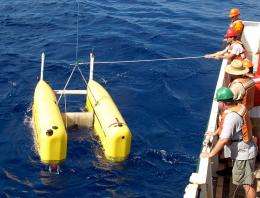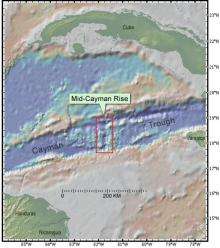Nereus being lowered into the water. Credit: WHOI
A team of oceanographers and astrobiologists is currently exploring one of the deepest points in the Caribbean Sea. Follow their blog as they search for life in this extreme seafloor environment.
This October and November, a team of oceanographers and astrobiologists has set out to explore one of the deepest points in the Caribbean Sea. Their goal is to map the region and search for life in the extreme seafloor environment.
The study area in the western Caribbean Sea is south of Cuba and Jamaica, and close to the Cayman Islands. Also known as the Mid-Cayman Spreading Center, this is one of Earth’s deepest and slowest-spreading mid-ocean ridges. Such regions are where two of Earth’s tectonic plates are ripped apart and new material wells up from the Earth’s interior. The Mid-Cayman Spreading Center is approximately 110 kilometers (68 miles) long and spreading apart at an ultra-slow rate of less than 20 millimeters (0.9 inches) per year.
The scientists will search for hydrothermal vent systems—natural seafloor plumbing systems where cold seawater circulates down into the hot, freshly-formed oceanic crust. The heat and mineral-rich fluids released by the seafloor vents at other locations on Earth have been found to support complex ecosystems of exotic organisms.
Using the new hybrid underwater robotic vehicle Nereus, the scientists hope to reach the bottom of the Mid-Cayman Rise. The maximum depth is just over 6,800 meters (4.2 miles) deep, so Nereus could extend their investigations beyond the reach of other research submersibles.
If the science team finds life at such great depths, their discovery will extend the known limits to life on our planet in terms of pressure, temperature, and vent fluid chemical compositions. The research also could provide new insights into the possible origins and evolution of Earth’s biosphere, since many scientists believe that life originated at similar hydrothermal vent systems about 4 billion years ago.
Hydrothermal circulation can arise on any planet that has liquid water and a source of heat, so the research could even provide a window on chemical conditions that might have given rise to life on other worlds.
From October 7 to October 26, the Nereus robot will swim freely as an autonomous underwater vehicle (AUV). In this AUV mode, Nereus will be used to survey large areas of the depths and map the seafloor. When Nereus has located something interesting, it can be brought back on board the ship and transformed into a remotely-operated vehicle (ROV) tethered to the ship via a microthin, fiber-optic cable. Through this tether, Nereus can transmit high-quality, real-time video images back to pilots on the ship. The pilots can then send commands to the vehicle to collect samples or conduct experiments using its manipulator arm.
After a brief port call in Georgetown, Caymen Islands, Nereus officially switches from AUV to ROV mode. This last phase of the expedition will take place from October 29 to November 6, and a new set of specialist scientists will be on board. Nereus will have up to eight hours of sampling per deployment at any vent site or other areas of interest. The vehicle will perform a combination of geochemical and biological sampling of vent fluids, minerals, hydrothermally altered rocks, large volume filtration (to sample chemicals or microbial life in the vent fluid) and extensive sampling of any megafauna.
Mid-Caymen Rise study area
According to Cindy Lee Van Dover, director of the Marine Laboratory at Duke University and one of the expedition scientists, exploration of the Mid-Caymen Rise potentially could lead to the discovery of new life forms.
“If we do find vents, we are certain to find animal types never - ever - seen before, ones that likely exploit unimagined adaptations to survive under the extreme conditions we expect to find more than 5000 meters below the surface of the sea,” she notes. “Imagine the challenge of preparing for a scientific expedition where one has no idea what kind of animal will be discovered.”
Another expedition scientist, Max Coleman of NASA’s Jet Propulsion Laboratory, will be identifying and sampling minerals at the vents and from the seafloor. The types of minerals found could indicate how fluid compositions are used as sources of energy by living organisms, and determine the amount of life such energy could support.
By exploring this extreme and previously uninvestigated section of the Earth’s deep seafloor, the scientists seek to extend our understanding of the environmental limits for life on Earth. They also help prepare for future efforts to search for life on other planets.
For Coleman, the Mid-Cayman location is the best terrestrial analogue for the hydrothermal vents believed to exist on Europa, the icy moon of Jupiter. This research therefore could help develop the protocols for an autonomous search for hydrothermal vents, and life, at the bottom of the salty ocean on Europa.
This expedition is funded by NASA’s Astrobiology Science and Technology for Exploring Planets (ASTEP) program.
Read the scientists’ blogs from the field at www.whoi.edu/page.do?pid=34695
Source: WHOI, via Astrobio.net























